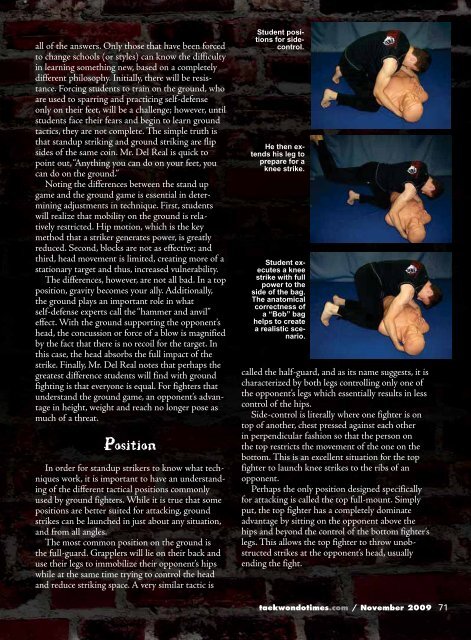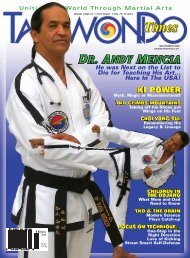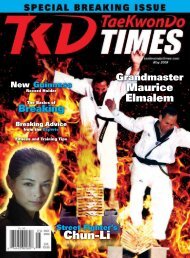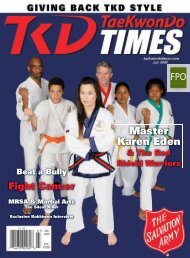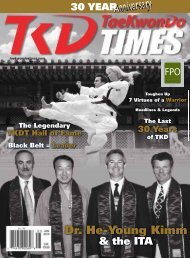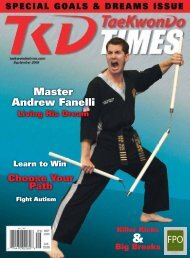Grandmaster Ken MacKenzie - Taekwondo Times
Grandmaster Ken MacKenzie - Taekwondo Times
Grandmaster Ken MacKenzie - Taekwondo Times
Create successful ePaper yourself
Turn your PDF publications into a flip-book with our unique Google optimized e-Paper software.
all of the answers. Only those that have been forced<br />
to change schools (or styles) can know the difficulty<br />
in learning something new, based on a completely<br />
different philosophy. Initially, there will be resistance.<br />
Forcing students to train on the ground, who<br />
are used to sparring and practicing self-defense<br />
only on their feet, will be a challenge; however, until<br />
students face their fears and begin to learn ground<br />
tactics, they are not complete. The simple truth is<br />
that standup striking and ground striking are flip<br />
sides of the same coin. Mr. Del Real is quick to<br />
point out, “Anything you can do on your feet, you<br />
can do on the ground.”<br />
Noting the differences between the stand up<br />
game and the ground game is essential in determining<br />
adjustments in technique. First, students<br />
will realize that mobility on the ground is relatively<br />
restricted. Hip motion, which is the key<br />
method that a striker generates power, is greatly<br />
reduced. Second, blocks are not as effective; and<br />
third, head movement is limited, creating more of a<br />
stationary target and thus, increased vulnerability.<br />
The differences, however, are not all bad. In a top<br />
position, gravity becomes your ally. Additionally,<br />
the ground plays an important role in what<br />
self-defense experts call the “hammer and anvil”<br />
effect. With the ground supporting the opponent’s<br />
head, the concussion or force of a blow is magnified<br />
by the fact that there is no recoil for the target. In<br />
this case, the head absorbs the full impact of the<br />
strike. Finally, Mr. Del Real notes that perhaps the<br />
greatest difference students will find with ground<br />
fighting is that everyone is equal. For fighters that<br />
understand the ground game, an opponent’s advantage<br />
in height, weight and reach no longer pose as<br />
much of a threat.<br />
<br />
In order for standup strikers to know what techniques<br />
work, it is important to have an understanding<br />
of the different tactical positions commonly<br />
used by ground fighters. While it is true that some<br />
positions are better suited for attacking, ground<br />
strikes can be launched in just about any situation,<br />
and from all angles.<br />
The most common position on the ground is<br />
the full-guard. Grapplers will lie on their back and<br />
use their legs to immobilize their opponent’s hips<br />
while at the same time trying to control the head<br />
and reduce striking space. A very similar tactic is<br />
Student positions<br />
for sidecontrol.<br />
He then extends<br />
his leg to<br />
prepare for a<br />
knee strike.<br />
Student executes<br />
a knee<br />
strike with full<br />
power to the<br />
side of the bag.<br />
The anatomical<br />
correctness of<br />
a “Bob” bag<br />
helps to create<br />
a realistic scenario.<br />
called the half-guard, and as its name suggests, it is<br />
characterized by both legs controlling only one of<br />
the opponent’s legs which essentially results in less<br />
control of the hips.<br />
Side-control is literally where one fighter is on<br />
top of another, chest pressed against each other<br />
in perpendicular fashion so that the person on<br />
the top restricts the movement of the one on the<br />
bottom. This is an excellent situation for the top<br />
fighter to launch knee strikes to the ribs of an<br />
opponent.<br />
Perhaps the only position designed specifically<br />
for attacking is called the top full-mount. Simply<br />
put, the top fighter has a completely dominate<br />
advantage by sitting on the opponent above the<br />
hips and beyond the control of the bottom fighter’s<br />
legs. This allows the top fighter to throw unobstructed<br />
strikes at the opponent’s head, usually<br />
ending the fight.<br />
taekwondotimes.com / November 2009 71


